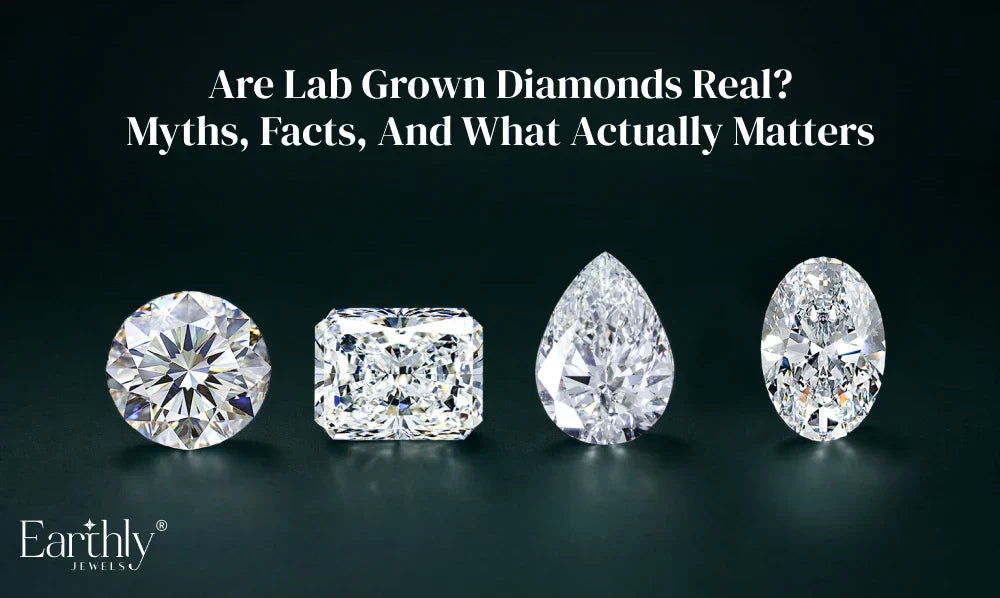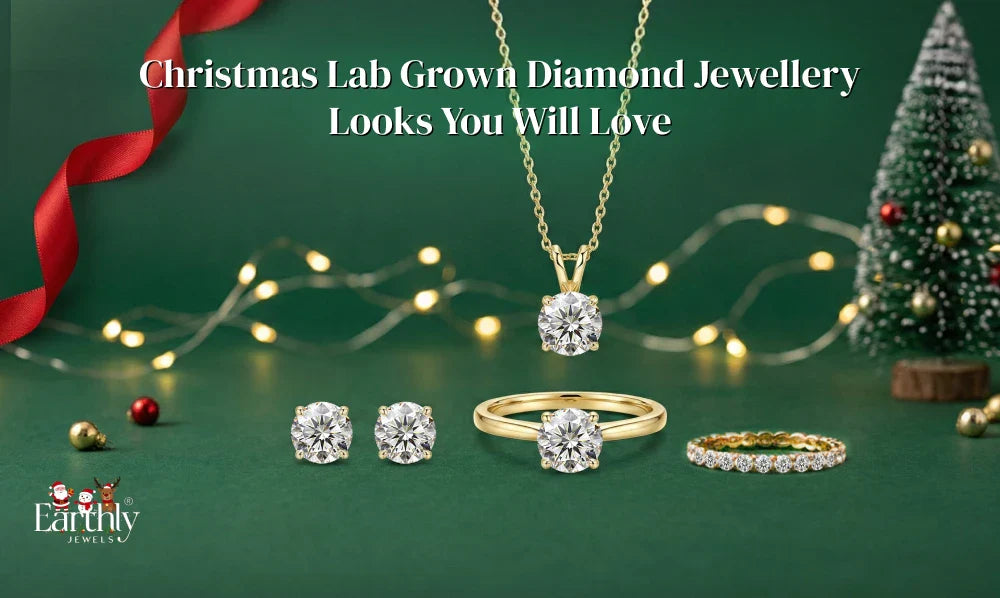
Discover how carat weight shapes appearance, price, and practicality when shopping ethical, lab grown diamonds.
Selecting the right carat weight is one of the most exciting and sometimes confusing steps in buying any diamond piece. Carat influences how large a stone looks, how much sparkle it delivers, and of course how much you pay. Yet weight is only part of the story, especially when Lab grown diamonds India shoppers can now access premium sizes at costs unthinkable only a decade ago. This guide unpacks everything you need to know, helping you reach a confident decision whether you are browsing a Lab grown solitaire ring, earrings, or a pendant.
What “Carat” Really Means
Learn what a carat truly measures and why two diamonds with the same weight can look noticeably different in size depending on their cut and proportions. This is especially important when choosing lab grown diamonds, as their precision-cut quality can enhance both size and sparkle.
Carat refers to the weight of a diamond and is a globally recognized standard, though it doesn't directly reflect how large the diamond appears. One carat equals exactly 200 milligrams. While two stones that each weigh one carat sit on a scale identically, they can still look dramatically different. Why? This is due to the fact that a diamond’s proportions greatly influence how its weight translates to what you actually see.
a. Carat vs. Size
Explore how a diamond’s proportions—especially its depth—can influence its face-up size, with shallow cuts often appearing larger due to their weight being spread across a wider surface. A deep‑cut stone concentrates weight vertically, appearing smaller on the hand but thicker when viewed from the side. This is why upgrading from a 0.90 ct to a 1.00 ct diamond may result in little noticeable size difference, especially if the cut quality varies.
b. Carat vs. Karat

Avoid a common mix‑up between diamond weight and gold purity.
New buyers frequently confuse carat the unit used to measure a diamond's weight with karat, which indicates how pure gold is. A helpful tip: 'carat' is spelled with a 'c' for gemstones, while 'karat' with a 'k' relates to gold. These two terms refer to completely different aspects of jewellery.
Why Lab Grown Diamonds Change the Carat Conversation
See how man made diamonds unlock larger‑carat dreams without ballooning costs or ethics concerns.
Traditional wisdom says “larger equals exponentially more expensive.” That was true when mined diamonds were the only option and rough supply limited bigger stones. lab grown diamonds overturned that rule. Created in high‑tech growth chambers, they cost 30–50 percent less than comparable mined stones while sharing identical optical and chemical properties.
a. Bigger Dreams, Same Budget
Find out how far your rupee goes when you swap mined for lab‑grown.
If a mined one‑carat solitaire stretches your budget, a Lab grown engagement ring might let you step up to 1.25 ct or even 1.50 ct while staying within the same spending limits. Similarly, matching Lab grown diamond engagement ring and wedding band sets become attainable without compromising on clarity or colour.
b. Ethical and Environmental Value
Spend more on size knowing the purchase stays environmentally responsible.
Beyond price, lab grown diamonds eliminate mining impact. Couples can therefore invest in a heavier stone and still feel confident their purchase aligns with their values.
c. The Impact of Carat on a Diamond’s Appearance and Brilliance
Understand how factors like cut, shape, and finger coverage influence how a diamond looks, proving that carat weight alone doesn't determine beauty. A diamond’s overall brilliance comes from the perfect balance of cut, colour, clarity, and carat working in harmony.
- Cut: Among all the features that define a diamond, cut has the greatest influence on how big and brilliant it looks. A well-executed cut enhances light reflection, allowing even smaller lab grown diamonds to outshine larger ones with inferior craftsmanship.
- Shape: Diamonds like oval, pear, and emerald cuts often seem bigger than round diamonds of the same carat since their stretched shapes spread weight across a wider area.
-
Finger Coverage: It's the diamond's diameter—not its depth—that determines how much of your finger the stone visually covers. Compare millimetre measurements, not just carats, when judging size.
Choosing Carat by Jewellery Type
Match ideal carat ranges to rings, earrings, pendants, and anniversary pieces.
a. Engagement Rings
See which carat windows balance presence, comfort, and cost for brides‑to‑be.
Many brides exploring lab grown diamonds often choose stones between 0.75 and 1.50 carats, offering a striking presence without overwhelming the hand. Those opting for vintage or halo settings may go as low as 0.60 ct, as the surrounding melee diamonds enhance the overall appearance, making the centre stone look larger.
Others embrace modern minimalism and jump to 2 ct, enjoying lab grown diamonds affordability.
Solitaire vs. Halo
Learn how different setting styles can impact how large and brilliant a diamond appears.
-
Solitaire: The centre stone stands alone; carat weight carries the entire aesthetic.
- Halo: A band of tiny diamonds frames the central stone, enhancing its appearance and often making it seem nearly half a carat bigger.
b. Earrings
Identify comfortable yet eye‑catching weights for daily studs or statement drops.
Everyday stud earrings featuring lab grown diamonds typically range from 0.25 to 0.50 ct each, offering elegant sparkle without weighing down the earlobes. For more glamorous occasions, 1 ct per ear delivers stunning brilliance while still feeling comfortable.
c. Pendants
Select a carat size that flatters the neckline without tipping chains.
A single 0.50 ct stone gleams subtly against the collarbone. Those wanting a statement centerpiece often select 1.25 ct + to stand out above formal wear.
d. Anniversary Bands and Stackable Rings

Use lab grown diamonds in multiple smaller stones to distribute carat weight evenly, perfect for creating stackable ring styles or the seamless sparkle of an eternity band.
Stacking rings trend anywhere from 0.10 – 0.30 ct each so multiple bands layer neatly, but eternity or five‑stone anniversary bands may total 1–2 ct combined weight for full‑circle sparkle.
Balancing Carat with Finger, Hand, and Face Proportions
Achieve harmony by matching diamond size to your unique physical features.
a. Finger Size
Use ring size as a starting point for proportional centre stones.
Ring size 5 or below typically suits 0.50 – 1 ct stones. Heavier diamonds may extend beyond knuckle width and appear disproportionate. Sizes 6–8 accommodate 1.25 – 2 ct comfortably, while size 8.5 + can showcase 2.50 ct without looking oversized.
b. Hand Shape
Let finger length guide your choice of diamond outline for flattering effect.
-
Long, slender fingers: Benefit from elongated shapes (oval, marquise) that accentuate length without adding bulk.
-
Shorter fingers: Round or princess cuts concentrate sparkle centrally, giving an illusion of length.
c. Face Shape for Earrings

Complement facial contours by matching stud shapes and sizes.
Round faces balance with elongated drops or pear studs; heart‑shaped faces suit round or princess studs; angular faces soften with cushions or ovals.
Budget Strategies for Smart Carat Decisions
Maximise value by timing, trading, and prioritising the Four Cs.
a. The “Magic Number” Thresholds
Avoid sharp price increases by selecting diamond carat weights just under the most common size benchmarks. Lab grown diamonds that measure slightly under popular sizes—like 0.48 ct instead of 0.50 ct or 0.96 ct instead of 1 ct—often appear almost the same in size but come with savings of 10–15%.
b. Trade‑Off Hierarchy
Prioritise sparkle and overall appearance over simply going for a higher carat weight.
If funds are limited, prioritise cut first, colour second, clarity third, carat last. A flawless two‑carat diamond lacking sparkle disappoints more than a perfectly cut one‑carat fireball.
c. Future Upgrade Paths
Plan ahead with jewellers who offer credit toward bigger stones later.
Many retailers provide lifetime upgrade programs. Starting with a 0.80 ct today may allow an easy swap to 1.20 ct on a future milestone—without repurchasing the entire setting.
Common Carat Myths—Debunked
Separate fact from fiction before you set foot in a showroom.
a. Myth: A Heavier Diamond Always Looks Bigger
Too much depth can hide a diamond’s weight in parts that don’t contribute to how large it looks from the top..
Reality: Depth‑heavy stones can hide carat weight below the setting. Examine millimetre spread rather than weight alone.
b. Myth: Carat Equals Sparkle
Light performance, not mass, creates brilliance.
Reality: Sparkle stems from cut quality. A finely cut smaller diamond can appear more brilliant than a bigger stone with poor symmetry.
c. Myth: Only Round Diamonds Show True Size
Fancy-shaped diamonds usually offer more visible surface area for each carat compared to traditional cuts.
Reality: Fancy shapes often deliver more face‑up surface per carat, providing a larger look for less weight.
d. Myth: Lab Grown Stones Are Lighter Than Mined
Physics makes no distinction between origins.
Reality: Carat measures weight alone, so lab grown diamonds and mined diamonds of the same carat have identical weight and are evaluated using the same grading standards.
Practical Tips Before You Buy
Simple actions that safeguard satisfaction and value.
a. Ask for Diameter Measurements
Millimetres tell the real size story.
Look for the diamond’s exact dimensions in millimetres on the certificate or product listing—these reveal its true size more accurately than carat weight alone.
b. View Under Different Lighting
Evaluate the diamond’s brilliance under various lighting conditions such as natural light, indoor lighting, and spotlights..
Examine the diamond in daylight, LED, and jewellery spotlights. Fire and brightness can appear very different across environments.
c. Try On Multiple Sizes
Side‑by‑side comparisons reveal subtle differences.
If you can, try on 0.75 ct, 1 ct, and 1.25 ct diamonds together—most buyers are surprised at how subtle the size differences appear in person.
d. Consider Your Lifestyle
Match stone height and weight to daily routines.
Professionals who use their hands extensively may prefer a lower‑profile 0.80–1.00 ct bezel setting for durability, whereas a socialite attending formal events might relish a 2 ct cathedral‑set showpiece.
e. Confirm Return and Upgrade Policies
Peace of mind comes from flexible seller terms.
Even with careful planning, seeing the stone on your hand can change your perception. Make sure the retailer offers a fair return or upgrade policy within a set timeframe.
Final Thoughts
Bring together ethics, beauty, and budget for a lifetime of sparkle.
Selecting the ideal carat comes down to finding the right balance between appearance, affordability, individual style, and ethical considerations. Advances in lab grown technology have opened the door for more people to enjoy larger, brighter diamonds without the traditional price tag or environmental baggage. Whether you settle on a classic 1 ct Lab grown solitaire, delicate 0.30 ct earrings, or an ambitious 2 ct Lab grown diamond engagement ring, the smartest purchase is the one that feels perfect every time you glance at it.
By focusing on cut quality, understanding how carat weight really translates to size, and leveraging the affordability of Man made diamonds, you can secure a piece of jewellery that shines brilliantly today and remains cherished for decades to come.
At Earthly Jewels, we make choosing the perfect carat simple and stress-free. Our handcrafted lab grown diamond jewellery blends beauty, ethics, and value—so whether you're after a classic lab grown solitaire or a bold engagement ring, you’ll find a piece that truly shines.






Share:
What Type of Gold Should You Buy? The Ultimate Breakdown by Use & Value
Jewelry Gifting Guide for Every Indian Festival: From Ancient Traditions to Modern Elegance